MOSAIC: Artist Interviews
By Susan Mariano, CMNH Intern
BECKY FIELD
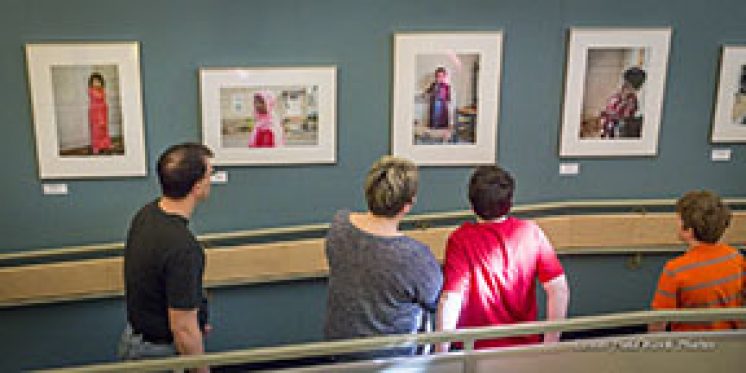 Q. Your photographs capture the optimistic joy of childhood and the strong desire to embrace and rejoice in the freedom to express, celebrate and share one’s colorful cultural heritage. While the immigrants and refugees from Africa and Southeast Asia may outwardly look and dress differently than those born here in the United States, they share many of the same family values as their fellow American-born neighbors and should be respected and appreciated for their differences.
Q. Your photographs capture the optimistic joy of childhood and the strong desire to embrace and rejoice in the freedom to express, celebrate and share one’s colorful cultural heritage. While the immigrants and refugees from Africa and Southeast Asia may outwardly look and dress differently than those born here in the United States, they share many of the same family values as their fellow American-born neighbors and should be respected and appreciated for their differences.
Many of the people you have immortalized on film have come to New Hampshire seeking safety and a better life for their children. However, it was a shameful local act of hate that inspired you to begin your photographic journey. What signs have you seen that the tides of understanding and embracing cultural diversity are changing here in New Hampshire?
A. The act of hate that inspired me to do this photographic project was immediately countered by a large community response that started the "Love Your Neighbor" Coalition. The hate was from one person, the response was from a whole community. Since then, my photography has been shown in many exhibits and talks that I have given in several New Hampshire communities. I have seen in the response to those events that feature the lives of our immigrant and refugee neighbors, and in the out-pouring of interest in by book, Different Roots, Common Dreams, that there is a growing interest and desire to welcome for people of different cultures who resettle in our communities. Through these photographs, the broader public has come to know our immigrant neighbors, and that knowing has planted the seeds of understanding and compassion.
SKIP SMALL
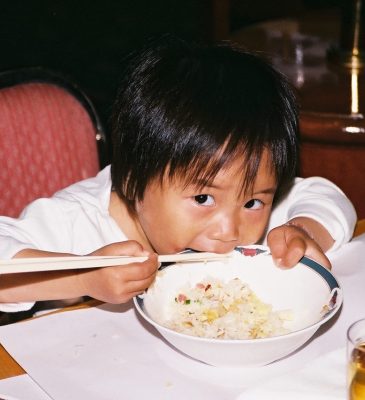 Q. The photographs you have taken of Chinese children living their everyday lives, hanging out with friends, riding on a bicycle and playing outside in the dirt illustrate that the simple things that bring one joy during the days childhood are pretty much universal.
Q. The photographs you have taken of Chinese children living their everyday lives, hanging out with friends, riding on a bicycle and playing outside in the dirt illustrate that the simple things that bring one joy during the days childhood are pretty much universal.
As a retired pediatrician who accompanies groups of prospective parents on the journey to meet their adoptive children for the first time, what would you like to say to couples who are considering becoming parents to children from other cultures?
A. My advice to people thinking of adopting children from a different culture would be no different than I would give to any potential parents. Raising children is a demanding challenge whether they are naturally yours, adopted from your culture, or adopted from a different one. If you are afraid of challenges, don’t have kids. If you embrace challenges, go for it!
SAYAKA and SETH BLEWITT
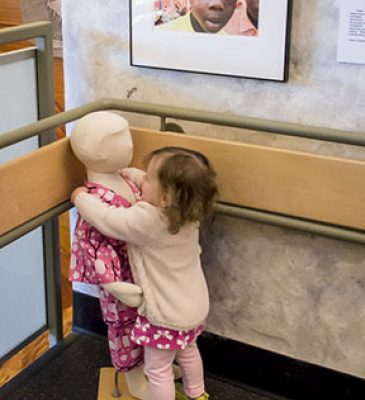 Q. The images and objects that you have curated, providing a glimpse into the life of a child from Japan, were uniquely enlightening. Finally, I understand the significance of the Japanese cherry blossoms! The celebrations of Hina Matsuri and Tango no Sekku show how truly important and respected children are in the lives of the Japanese.
Q. The images and objects that you have curated, providing a glimpse into the life of a child from Japan, were uniquely enlightening. Finally, I understand the significance of the Japanese cherry blossoms! The celebrations of Hina Matsuri and Tango no Sekku show how truly important and respected children are in the lives of the Japanese.
What message are you hoping the people who view your collection will take away with them?
A. I'm glad that the exhibit had that effect of providing some insight into Japan through a child's eyes. Think of the first moment when you saw the topics posted on the wall of the
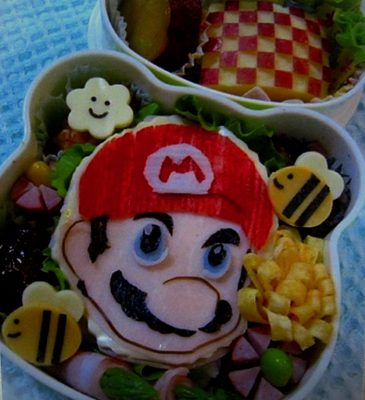
Curiosity, wonder, bemusement, and excitement for something new are a little harder to come by when you're older, unless you look for it. In exploring another culture, adults can feel like a kid again because they encounter a barrage of new experiences. So hopefully in the short term visitors, adults and children alike, have found these wondrous emotions. And in the long term I hope that this exhibit has motivated adults to seek out new experiences for themselves and to share with others.
Rocks Rock!
Now on view in the Naturalist Study
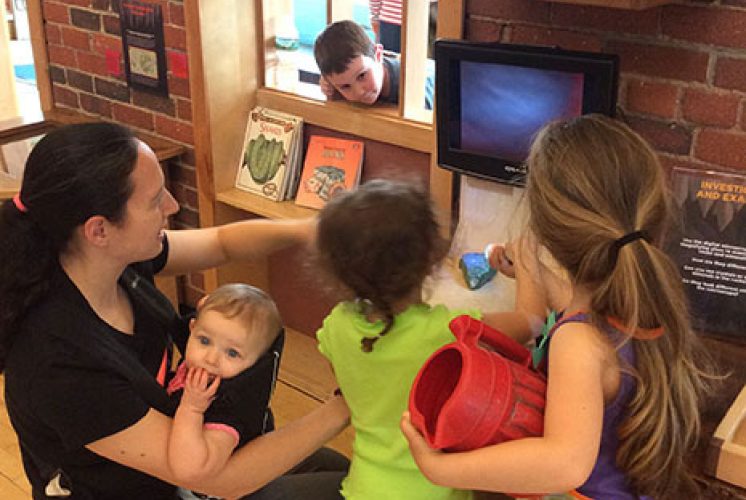 We have a great collection of rocks, minerals and fossils on display in our Naturalist Study exhibit, thanks to the Woodman Museum. This exhibition is a collaborative project that relates the collections and missions of Dover's two museums, bringing rocks and minerals from the Woodman Museums's permanent collection to the Children's Museum of New Hampshire. There are rocks, minerals, crystals and fossils of all shapes, ages, and origins in our display cases, as well as a variety of rocks that are out to be touched and examined under a large magnifying glass or our digital microscope.
We have a great collection of rocks, minerals and fossils on display in our Naturalist Study exhibit, thanks to the Woodman Museum. This exhibition is a collaborative project that relates the collections and missions of Dover's two museums, bringing rocks and minerals from the Woodman Museums's permanent collection to the Children's Museum of New Hampshire. There are rocks, minerals, crystals and fossils of all shapes, ages, and origins in our display cases, as well as a variety of rocks that are out to be touched and examined under a large magnifying glass or our digital microscope.
You can learn about how rocks are formed and then changed over time (the Rock Cycle) while examining the rock specimens. Did you know that every rock on this planet, or even other planets, falls into one of 3 categories - Igneous, Metamorphic and Sedimentary. Come and find out what makes these rocks different from each other. Since we are learning about rocks, of course we have to talk about volcanoes! Volcanoes are a big part of the Rock Cycle, and a very interesting natural phenomenon. We have some volcanic rocks on display that show how different rocks form during different types of eruptions. Did you know their used to be several volcanoes in New Hampshire? Geologists come from all over the world to study the remnants of the volcano that is now know as the Ossipee Mountain Range.
We rotate The Naturalist Study exhibits by season so there is always something new to see. Rocks will be on display through June, 2016. We'll then have a short exhibition on Sharks for Shark Week, my favorite. We'll end the summer with an exhibit all about local wildlife in the Gulf of Maine.
Thanks again to the Woodman Museum for lending us your awesome rock collection!
The Naturalist Study exhibit is sponsored by The Little Harbor Charitable Foundation.
New STEAM Programs
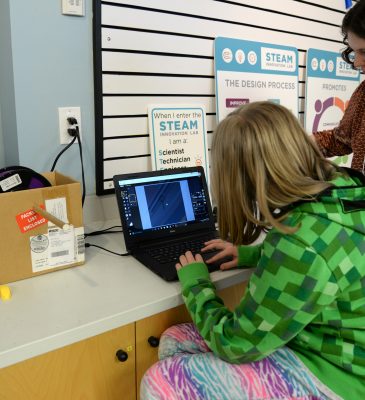 The Science, Technology, Engineering, Arts and Math (STEAM) Innovation Lab at the Children’s Museum of NH is now a permanent part of the museum and for the last few weeks has been hosting drop-in events every day. The Lab is designed to provide students, teachers and visiting families with enriching hands-on STEAM learning experiences.
The Science, Technology, Engineering, Arts and Math (STEAM) Innovation Lab at the Children’s Museum of NH is now a permanent part of the museum and for the last few weeks has been hosting drop-in events every day. The Lab is designed to provide students, teachers and visiting families with enriching hands-on STEAM learning experiences.
“The response has been wonderful!” shared Jane Bard, President of the Children’s Museum of NH. “We’ve had schools, teachers, and kids of all ages use the STEAM Lab, and with each new interaction, we feel confident that we’ve created a useful and timely resource.” Programs in the STEAM Innovation Lab can be tailored to any group.
Learning Labs are for schools and organized groups and come with themes like “Keeping Current: Circuits” or “Mission to the Moon.” New spring and summer classes and camps for kids are being scheduled now and some of those themes include “Sci Fi Science” and “Learn to Code.” The Children’s Museum educators are gearing up to offer Professional Development opportunities for teachers with workshop themes like “NGSS Crosscutting Standards: What Are They and How Do I Incorporate Them?” The Museum is currently partnering with UNH Cooperative Extension to offer “Inquiry Teaching Methods: Grounding STEM Education Programs in Science Practices” to 17 classroom educators from throughout the region.
Debuting at the Museum’s Earth Day Celebration on April 22 will be a new “Eco Boys and Girls Science Bites” program. CMNH has partnered with Eco Boys and Girls to create a series of 12 hands-on science demonstrations and activities featuring five lovable animated characters, each designed to educate pre-K to third grade children about the Earth, sustainability and our interconnectedness. Ernie Earth preserves the natural world and its ecosystems; Lulu Love demonstrates the importance of loving herself, others and all living things; Patsy Peace resolves conflicts so that humans and other living things can exist in peaceful ways; Ray Recycle shows people ways to reuse, reduce and recycle, and Sammy Sun spreads the word about conservation and protecting natural resources. These programs will be drop-in and free with museum admission. The lessons will also be available on the Museum’s website for free use in classrooms, after school programs or by families at home.
The STEAM Innovation Lab doesn’t get much quiet time because every day the museum is open, there is a scheduled drop-in activity included with admission so that guests of all ages can experience this unique space. Some programs encourage kids and parents to work together to build a prototype of an invention. Other programs lead kids through an engineering challenge to build boats, bridges or towers. Much of the Lab’s focus is on problem-solving and coming up with creative solutions. Other days visitors will be engaged with the Lab’s technology like the 3D printer and the FLoid® Imaging System microscopes provided by Thermo Fisher Scientific, one of the Lab’s legacy sponsors. Check our daily calendar on the Museum’s website: www.childrens-museum.org
In addition to all the daily drop-in programs that are free with museum admission, there are also programs that may cost a little extra to attend, but are perfect opportunities for adults and kids to learn together. Storybook STEAM happens most Fridays 2-2:45pm and is perfect for ages 3.5-5. Kids hear STEAM-related stories, read by a Museum educator, and then work with their adults on a project inspired by the story. Storybook STEAM doesn’t require registration and is $10 per adult/child pair for Members and $12 for adult/child pair for Non-members. There are also adult and child workshops on one Saturday a month called “STEAM Saturday Workshops,” The latest one is this coming Saturday, April 16 from 10:30-11:30am. Kids and adults can create their own Shrinky Dinks Sculptures to take home! On Saturday, May 14 from 10:30-11:30am adults can learn how to code their own video games right along with their kids (ages 8-12)! The cost for workshops like these is $15 per adult/child pair for Members and $20 for Non-members. (Does not include Museum admission.)
 To help facilitate these kinds of coding workshops, the Children’s Museum has partnered with local software developer, James Terry, to create the museum’s first app. The “CMNH Game Maker” app has been developed to be used on the STEAM Innovation Lab’s iPads and allows users to switch seamlessly between coding, creating art, debugging, and testing their own video games. “Our goal with CMNH Game Maker is to provide a single tool that lets students (and interested adults) have everything they need to create their first video game,” shared Museum Educator (and James’ daughter) Sarah Terry. The app is currently being Beta tested by enthusiastic museum students throughout the spring. “Sarah and I are learning a lot watching the kids use the App and it’s given us a lot of ideas for new features and ways to make it even more accessible for kids who want to turn their passion for playing video games into the skill to make them," said James.
To help facilitate these kinds of coding workshops, the Children’s Museum has partnered with local software developer, James Terry, to create the museum’s first app. The “CMNH Game Maker” app has been developed to be used on the STEAM Innovation Lab’s iPads and allows users to switch seamlessly between coding, creating art, debugging, and testing their own video games. “Our goal with CMNH Game Maker is to provide a single tool that lets students (and interested adults) have everything they need to create their first video game,” shared Museum Educator (and James’ daughter) Sarah Terry. The app is currently being Beta tested by enthusiastic museum students throughout the spring. “Sarah and I are learning a lot watching the kids use the App and it’s given us a lot of ideas for new features and ways to make it even more accessible for kids who want to turn their passion for playing video games into the skill to make them," said James.
For more details and a schedule of events in the STEAM Innovation Lab, please visit our website. Thank you to our STEAM Innovation Lab founding sponsors Thermo Fisher Scientific, The Roger R. and Theresa S. Thompson Endowment Fund, Granite State Development Corporation and the Horne Family Foundation.
Watch Them Grow!
Anyone Can Grow Food Program at the Children’s Museum of NH
 Kids grow like weeds, but you won’t find any weeds growing in the garden at the Children’s Museum of New Hampshire in Dover! You will find lots of young, enthusiastic kid gardeners though, beginning this Saturday, April 16 at 10:15am. Guests of all ages will be working together to plant seeds, watch them grow, and then harvest their hard work all spring and summer.
Kids grow like weeds, but you won’t find any weeds growing in the garden at the Children’s Museum of New Hampshire in Dover! You will find lots of young, enthusiastic kid gardeners though, beginning this Saturday, April 16 at 10:15am. Guests of all ages will be working together to plant seeds, watch them grow, and then harvest their hard work all spring and summer.
The “Anyone Can Grow Food” program is led by University of New Hampshire Cooperative Extension Master Gardener Leslie Stevens, owner of Sidewalk Farms, and Xanthi Gray, the Children’s Museum of New Hampshire’s Education Coordinator. Working along with guests of the Museum, they turn nine raised garden beds into a thriving vegetable and herb garden.
The program begins with seed starting on Saturday, April 16 at 10:15am. Participants will learn how to start seeds indoors to get a jump-start on the growing season. Mini seed-starting greenhouses will be built where kids can grow their own Sugar Snap pea seedlings. Kids will learn about how and when to start their seeds indoors and when it’s safe to plant their seedlings outside. Everyone who participates will go home with a pack of seeds to try in their own gardens. And of course, Max the bunny will be on hand for friendly pats.
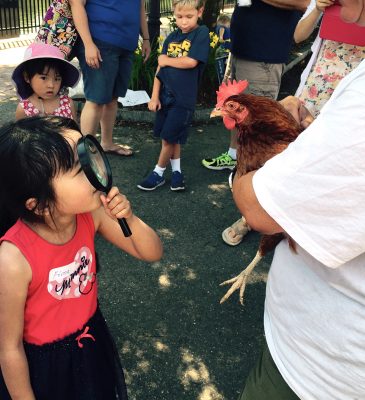
Summer planting starts a little early at CMNH with two “Anyone Can Grow Food” programs on Saturday, June 4. At 10:15am guests will gather to help plant the vegetable and herb garden and learn how to take care of their own plants. Pet Henrietta the chicken and then go home with a pack of seeds, or stick around for another program at 11:45am when visitors will learn how to create a potato tower! Did you know that if you have 6 hours of sunlight and just a 2-foot circle you can plant potatoes that will grow all summer!
To round out the season, come back for the harvest on Saturday, September 24 at 10:15am. Pick a pumpkin, pull up a carrot and dig a potato out of the gardens as staff gets ready to put them to bed for the winter. Kids will learn about composting bins and why worms are so important to keeping gardens healthy. Families will go home with a pumpkin and produce from the garden.
The Anyone Can Grow Food programs are free with Museum admission, but pre-registration is requested to help ensure enough supplies are available for each family. Please call 603-742-2002 to register for these or any programs at the Children’s Museum of New Hampshire.
Reflecting on my Summer Internship at CMNH
It's time to start thinking about summer internships. Read on to hear what this former intern had to say about her internship at the Children's Museum of New Hampshire.
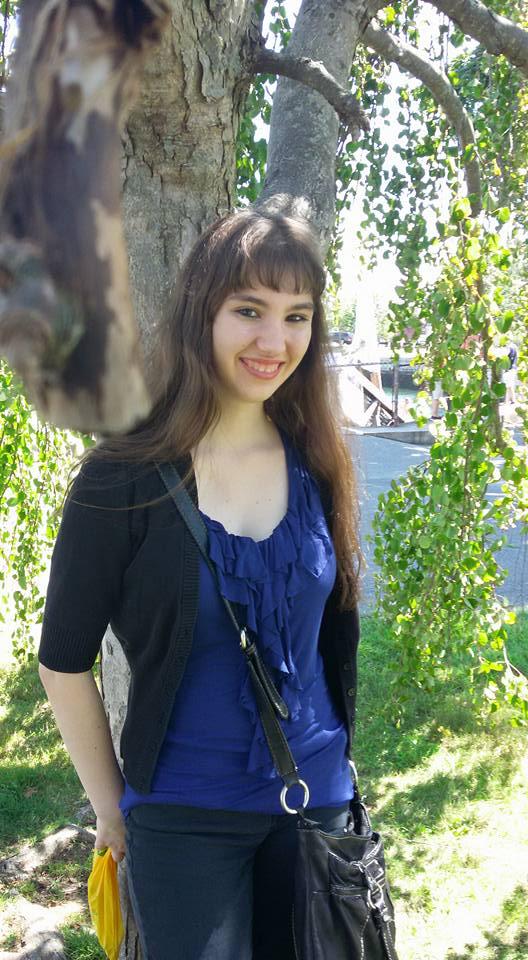 By: Amanda Girard
By: Amanda Girard
I remember visiting the Children’s Museum in Portsmouth when I was younger. I remember playing in the Yellow Submarine and the fishing boat and creating works of art in what is now known as the Muse Studio. I had a lot of really great memories there.
That younger version of myself could’ve never imagined that one day I would return here as an intern and spend a summer here. Yet, here I am on both the last day of my internship and my 20th birthday!
I have really enjoyed my time at CMNH and I have successfully completed so many projects that I am proud of. I am going to college for a degree in Professional Writing with a minor in Marketing and I really have combined the two in this internship with the Marketing department.
I had a few projects that spanned the length of my entire internship (From Mid-May to the beginning of August). I wrote biographies for all of the over 50 Makers who will be part of the 2015Dover Mini Maker Faire. I had never even heard of Maker Faire until I started to work here and I think it’s just an amazing idea that will only grow as time goes on. As I was writing the biographies, I would always get excited and wound up wishing that I could be around when it happens, as I will be studying abroad in Dublin at the time. Nevertheless, I am proud that I could be a part of getting people excited for Maker Faire this year!
I also worked for a majority of the summer interviewing office staff, museum educators, and volunteers for “Meet the Staff” blog posts for this blog. I enjoyed this project a lot because I got to meet many of the wonderful staff at the Children’s Museum. Everyone here is so kind and friendly and just a lot of fun! I got to experience what it is like to work in an office setting and I saw first-hand how a group of people with many different talents can come together for a common goal: in this case, to provide an amazing experience for children and their families.
Speaking of children and their families, I got to read what they thought of CMNH firsthand with another one of my ongoing projects. One of the first things that I did in the mornings when I arrived for work was check to see if there were any new visitor surveys. I gathered almost 40 surveys over the course of the summer and compiled them. Some outcomes of this were a tally of visitor’s favorite exhibits (with the Yellow Submarine at the top of the list!) and two blog posts about what the Museum offers to older kids and how our exhibits help toddlers learn through repetition.
Other things that I accomplished during my time here include writing tweets and Facebook posts (some things that I had never really tried before!), covering events like Group Visits and the Teddy Bear Clinic and Picnic, crafting emails, tracking visitor zip codes and writing press releases for Museum events and classes.
So what have I learned from doing all of this? Well, I’ve learned another way that I can use my writing in the future and I’ve learned the basics of marketing and social media outreach. I’ve learned about the amount of research that goes into marketing a company and a brand and I’ve learned that I actually really love doing that research! I have also learned what it’s like to work in an office and how to coordinate and work together to accomplish a goal.
But the biggest thing I think I’ve learned, that I already sort of knew, was that I really like working with children and seeing their reactions of joy and excitement when they see the finished product of something we have all worked so hard to create for them. I think that that is an interest that I would really like to pursue further and I’m not sure where that will lead me. But interning at CMNH this summer solidified that the interest is there and who knows where that will lead me in the future!
I am extremely thankful for the opportunity and experience that I have had at the Children’s Museum of New Hampshire this summer and for every amazing person that I have gotten the chance to meet in the process!
S.T.E.A.M. Innovation Lab Opens
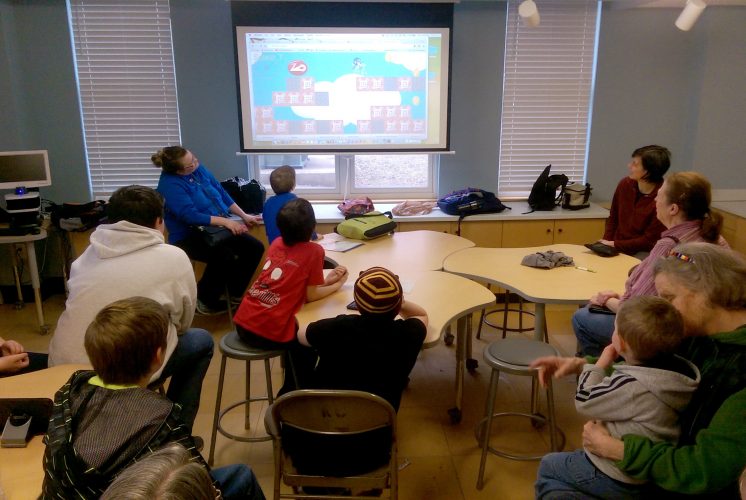
New space and high-tech equipment brings focus to Science, Technology, Engineering, Art and Mathematics
Dover, NH – (March 16, 2016) For the last few years, science, technology, engineering, art and math or STEAM, has been a hot topic when discussing early childhood education. However, the Children’s Museum of New Hampshire has been focused on all five areas since their inception 33 years ago. Now, with the opening of their STEAM Innovation Lab, through the generous sponsorship of Thermo Fisher Scientific, the Museum will have a dedicated space and high-tech equipment capable of supporting and engaging New Hampshire’s future innovators.
What is it?
When the STEAM Innovation Lab opens in mid-March, educators as well as children and families will be invited to use the lab to explore topics that focus on collaboration, critical thinking and making connections with the world outside the classroom. The space is designed as a prototype classroom of the future, with flexible furniture that can be reconfigured for a variety of tasks.
The room is equipped with a projector, iPads, materials for prototyping and designing as well as real tools and scientific equipment, including a 3-D printer and high-powered FLoid® Cell Imaging System provided by partner Thermo Fisher Scientific. Children can even learn how to code their own games on a “CMNH Game Maker” app designed specially for the Children’s Museum by local software developer James Terry. “We’ve already had kids ages 9 – 12 Beta test this Game Maker app in one of our camps and it was a huge success and resulted in some really fun and innovative games,” shared Jane Bard, President of the Children’s Museum of NH.
Expanding on a Well-Established Educator Resource
The Museum has a long history of engaging children in STEAM concepts: science through daily experiments; technology and engineering through Maker Clubs and the Dover Mini Maker Faire; math through their classes and camps; and art in practically everything. “The idea that STEAM concepts are out of reach for young children is false,” shared Jane Bard. “Here at CMNH we’ve been immersed in teaching these topics for many years and with the new STEAM Innovation Lab we are thrilled that we can grow as a resource to children, families and educators as we move into a more high-tech world.”
The STEAM Lab will certainly provide much needed support to NH educators. “We’ve consistently heard from teachers that they need support and training to assist them in teaching STEAM concepts” said Jane.
Fran Meffen, STEAM Academy Director at Dover Middle School, agrees. “The STEAM Innovation Lab (SIL) at the Children’s Museum of NH is a critical resource in providing immersion for children, teachers and community members into all things STEAM. STEAM project-based learning is central to the shift in education that is needed in schools to best meet the goal of having students college and career ready. The STEAM Innovation Lab will serve as an incubator for teachers, allowing them to bring their students on field trips where students will be active learners and the teachers can learn how to bring this experience back to their classrooms.”
Beyond the Classroom
While the STEAM Innovation Lab was created with an eye toward assisting NH’s educators, it is much more than that. The Museum will open the Lab to all museum guests weekly at scheduled times. “We’re planning a whole range of programs and activities that will utilize the space and equipment,” says Meredith Lamothe, Children’s Museum of NH Lead Educator. Storybook STEAM will focus on children as young as 3 years old, while STEAM Lab design challenges will be perfect for the entire family. The STEAM Saturday series will allow parents and children to collaboratively create things like ArtBots or Shrinky Dinks™ Sculptures. “It’s important to us that we continue to incorporate STEAM learning into our already fun and engaging museum environment,” says Lamothe “so that our visitors and members can see how this kind of learning is not just for a classroom setting!”
The Children’s Museum has a variety of programs in place to ensure that everyone who wants to visit the Museum, can, regardless of their economic situation. For example, families who present an EBT card at the door, can pay only $1 admission per person. This kind of all-inclusive access is crucial to leveling the playing field of educational privilege. “It is critical that we engage all children early in meaningful, participatory discovery in science, technology, engineering, mathematics and the arts and create pathways for that learning to continue throughout their education,” said Lauren Provost, Director of Science & Technology Outreach at Dartmouth College. “The Dartmouth Office of Science & Technology Outreach is excited to support these efforts.”
An Eye on the Future
With professional development and teacher training programs with titles like “Next Generation CrossCutting Concepts: What Are They and How Do I Incorporate Them?,” free individual admission for teachers who present a teacher ID, and the free STEM video series created by the Museum and available online, there are many ways that educators can utilize the Children’s Museum as a resource. “The STEAM Innovation Lab represents our commitment to the students, teachers and families of New Hampshire in inspiring all children to become the next generation of innovators and problem solvers,” says Jane Bard.
With the opening of the STEAM Lab, the Museum has an eye on the future, and that is something that has made business as well as education leaders sit up and take notice. “This will help spark our youth’s interest in STEAM while offering educators opportunities to hone their teaching skills and enhance self-directed and engaged STEAM learning in the classroom,” shared Tom Raffio, Chair of the NH State Board of Education and Chair of the New Hampshire Coalition for Business and Education. “If children are consistently exposed to active STEAM teachings early in life and they enjoy participating in these classroom lessons, it will improve their capacity and hunger for learning. If children are enthusiastic about the STEAM disciplines, it will help to develop a pipeline of inspired and engaged innovators, and benefit the next generation of New Hampshire’s workforce.”
Fran Meffen agrees. “While this is just one classroom in the Museum its impact will spread organically across NH.”
STEAM Innovation Lab founding sponsors are Thermo Fisher Scientific, The Roger R. and Theresa A. Thompson Endowment Fund, Granite State Development Corporation and the Horne Family Foundation. To learn more about the STEAM Innovation Lab click here.
A MOSAIC of Cultures to be Explored
Gallery 6, the space reserved for art inside the Children’s Museum of New Hampshire, will have a new exhibition opening on March 5 and featuring art from many different cultures. MOSAIC: Exploring Our Multicultural Neighborhood will be paired with a special celebration of cultural exploration on Saturday, March 12, where guests can taste North African cooking, enjoy traditional Bhutan dancing and music, try their hand at Chinese brush painting and take part in a community art project.
The art on view in MOSAIC will include photographs of immigrants and refugees living in New Hampshire taken by Becky Field from her book Different Roots, Common Dreams, which came out in the Fall of 2015. Photographer David Hiley, who traveled to Haiti with a group of Seacoast, NH medical professional volunteers in coordination with the Haitian Health Foundation, will present his series of Haitian “selfies” of children and parents. “My eye was drawn to the tension I saw between wrenching poverty and the vibrancy and dignity of these children,” shared David. “Allowing the children to take selfies captured the curiosity and joy common to children everywhere.” Also on view will be photographs of children from China taken by retired pediatrician Skip Small and a glimpse into the life of a child from Japan curated by Sayaka and Seth Blewitt. Also on view will be selected dolls from the Museum’s collection of dolls from around the world.
The special celebration of MOSAIC promises to be just as diverse as the cultures represented in the art itself. The event will be from 11am-2pm on Saturday, March 12 at the Children’s Museum of New Hampshire in Dover. Guests who come in traditional cultural costumes (super heroes and princess costumes do not apply) will receive half-off their individual admission. From 10:45am-Noon European classically trained chef Patrice Gerard will demonstrate North African cooking and guests can taste his vegetarian tagine with couscous. Becky Field will be on hand to talk about her photography project and her work documenting cultural, ethnic and religious diversity in NH. At 11:30am and 1pm dancers from Bhutan will demonstrate traditional dance and music in the Museum’s Muse Studio. David Hiley will be walking around the Museum taking “selfies” of guests who come dressed in their traditional costumes. Runjuan Huang will demonstrate Chinese brush painting and guests can try their hand at that or help create a community weaving project, which, when completed, will be installed on the exterior of the Children’s Museum. The opening celebration events are free with regular museum admission.
The MOSAIC exhibition will be on view through Tuesday, May 31 and is sponsored by Optima Bank and Trust, the New Hampshire State Council on the Arts and the Fuller Foundation. In addition to the art on view and special celebration event, every two weeks the Museum educators will focus on the cultures of different countries and feature country themed crafts and activities in the Muse Studio. The countries, in order of appearance, will include Tanzania, Peru, Haiti, Iceland, Japan, Pakistan and Canada. At the end of May, art projects and facts about all seven countries will be displayed together in the Muse Studio.
As always, no admission fee is required to view the art in Gallery 6. Regular admission applies for families who wish to also explore the rest of the Museum.
Un MOSAICO de Culturas
Un MOSAICO de Culturas para ser Exploradas en el Museo del Niño de New Hampshire
Galería 6, el espacio reservado para el arte en el Museo del Niño de New Hampshire, tendrá la apertura de una nueva exhibición el 5 de marzo, y presentará el arte de diversas culturas. MOSAICO: Explorando nuestra comunidad Multicultural, simultáneamente llevará a cabo una celebración especial de la exploración cultural, el sábado 12 de marzo, en donde los asistentes podrán degustar la cocina del Norte de África, disfrutar el baile y la música tradicional de Bután, probar sus destrezas con el pincel en la pintura China y formar parte de un proyecto de arte comunitario.
El arte visto en MOSAICO incluirá fotografías de inmigrantes y refugiados que viven en New Hampshire tomadas del libro Raíces Diferentes, Sueños en Común de Becky Field, el cual salió en el otoño del 2015. El fotógrafo David Hiley, quien viajó a Haití con un grupo del litoral, profesionales médicos voluntarios de NH en coordinación con la Fundación Sanitara de Haití, presentarán las series ‘selfies’ de niños y padres Haitianos. “Me llamo la atención lo que vi entre la desgarradora pobreza y la vitalidad y dignidad de esos niños”, “comentó David”. “Permitiendo capturar la curiosidad y alegría en común que todos los niños tenían por todas partes”. Asimismo serán expuestas fotografías de niños de China, tomadas por el pediatra jubilado Skip Small y se vislumbrará la vida de un niño de Japón capturado por Sayaka y Seth Blewitt. También estarán en muestra muñecas de alrededor del mundo seleccionadas de la colección del Museo.
La celebración especial de MOSAICO, promete ser tan diversa como las culturas presentadas en el arte mismo. El evento se llevará a cabo de 11am-2pm el sábado 12 de marzo en el Museo del Niño de New Hampshire en Dover. Los asistentes que vengan en sus trajes típicos (disfraces de superhéroes y princesas no aplican) pagarán la mitad en su admisión individual. De 10:45 am-a mediodía el chef Patrice Gerard capacitado en Europa, hará una demostración de la cocina del Norte de África y los invitados podrán degustar su tajine vegetariana con cuscús. Becky Field estará accesible para hablar de su proyecto fotográfico y su trabajo de documentación cultural, étnico y la diversidad religiosa en NH. A las 11:30am y 1pm bailarines de Bután harán una demostración de su baile y de su música tradicional en el Estudio Muse. David Hiley caminará alrededor del Museo tomando “selfies” a los invitados que vengan vestidos con sus trajes típicos. Runjuan Huang hará una demostración de la pintura China con pincel y los asistentes podrán también intentar hacerlo o ayudar a crear el proyecto comunitario, el cual, una vez completado será colocado en el exterior de Museo del Niño. La apertura de la celebración de los eventos son gratuitos con su admisión regular del museo.
La exhibición MOSAICO estará a la vista hasta el martes, 13 de mayo y es patrocinada por Optima Bank and Trust, el Consejo Estatal de Artes de New Hampshire y la Fundación Fuller. Además de la exposición de arte y la celebración especial, cada dos semanas los educadores del Museo harán manualidades y actividades culturales de diferentes países en el estudio Muse. Los países, en orden de aparición, incluirán Tanzania, Perú, Haití, Islandia, Japón , Pakistán y Canadá. A Finales de mayo, proyectos y situaciones acerca de los 7 países estarán juntos en exhibición en el Estudio Muse.
